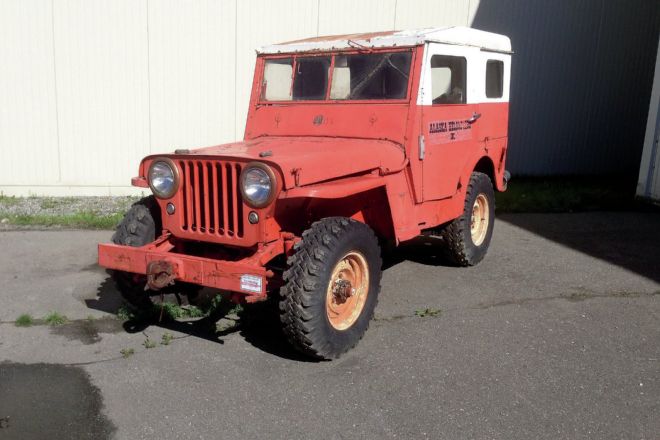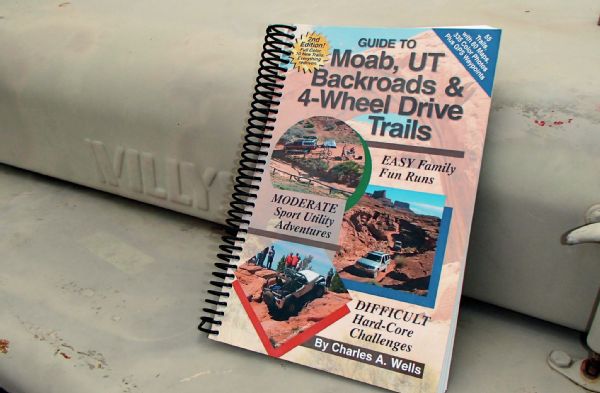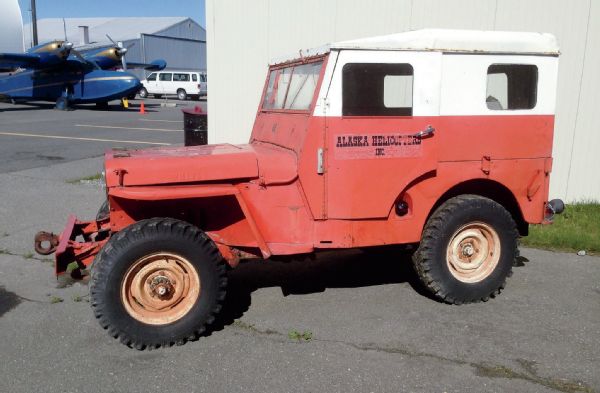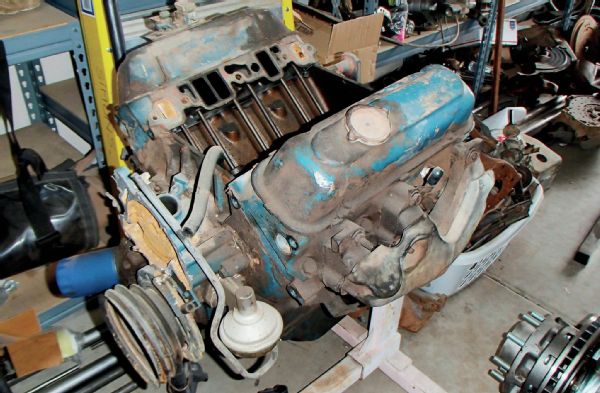
 Verne Simons
Senior Editor, Jp
Verne Simons
Senior Editor, Jp
Finding Trails
I have a new-to-me SUV. I’d really like a Jeep, but need something that gets good gas mileage for my growing family, and I want to take it out on some trails near where I live in Sacramento, California. The problem is I don’t know where any are, and I don’t know what my rig is truly capable of. I have been four wheeling a few times with my brother-in-law at family get-togethers. So, I know what I am missing and know enough to know I like it. How do I get started? Oh, by the way, my SUV has some sort of 4WD lock button that supposed to work while the vehicle is going under 20 mph, so that should help.
Tony Gordon
Via Facebook

Learning about local trails, and what your rig can do, can be difficult at first. I just recently bought a book called Guide to Arizona Back Roads & 4-Wheel Drive Trails by Charles A. Wells. I already own his guide book to Moab, and these books are a great way to get started and a great resource to help even an experienced wheeler remember just where that trail head is. I bought the Arizona version so I can research a few trails that I have never done within my home state. I just looked at funtrecks.com (the book series’ web site) for info to help you, and it looks like they have similar books about California trails. These books cover everything from easy trails or glorified dirt roads to difficult trails (like Pritchett Canyon in Moab, Utah, which requires a pretty well-prepped rig and an experienced driver) and everything in between. The books also include maps of the trails and some info on back-country exploration, driving, and recovery and survival if all goes wrong. Mileage numbers, trail descriptions, and GPS coordinates are listed in the book (GPS coordinates can be downloaded from the website too) to make sure you won’t get lost. The books are updated every few years, which is good since any trail or road can change even overnight. I would start there and see what you find. Just be sure to let someone know where you are headed and when you should be back before you head out to explore. You can also bring a friend, their SUV, and a tow strap just in case someone gets stuck. Avoid the tow straps with metal hooks on the ends. You want one with loops that can be slipped over tow hooks mounted to your vehicle’s frame.
Alternatively, you could look for a Jeep club in your area. This can also be a great way to learn more about using, protecting, and preserving off-road opportunities in your local area. At the same time, clubs can differ very greatly and can range from family oriented adventure clubs to drinking clubs where the members have many vices, including Jeep hoarding issues. Chances are they will do some judging of you depending on what your “SUV” is too—these are Jeep people, after all. Even if your SUV is a Fiat-based Jeep product or even a Liberty, don’t expect to fit in with the guys with Wranglers and CJs.
Rules, (besides letting someone know where you are going and when to expect your return) are pretty simple. Bring plenty of water (usually a minimum of 1-gallon per person, per potential day), warm clothes, a fire extinguisher, a spare tire (including the tools to change it), and a first aid kit. Some food is nice, but chances are you’ll eat it.
Also, learning about airing down your tires properly is a great way to improve your vehicles ride and traction off-road basically for free. Just don’t let too much air out or forget to air up when you return to pavement and hope to safely hurdle down the highway at a tailgater-encouraged California speed (between 90 and 95 mph).
Lastly, I’ll make an uninvited vehicle recommendation. Any Jeep or other 4x4 with a low-range transfer case that locks into 4-wheel-drive is going to be the best vehicle to use for this type of adventuring. Of course, that extra gearing adds weight, which detracts from fuel efficiency. Everything has compromises. A great vehicle to start with that gets, well, acceptable mileage in stock trim is a late ’90s to ’01 Jeep Cherokee. Also, if you can find one with low mileage, it will last for well over 200,000 miles, and they are relatively easy to maintain and repair. They make a good platform for modifications that will further destroy the fuel efficiency, all while making them much more capable off-road. Many in the Jeep world go for smiles per gallon rather than fuel efficiency.
What Is This?
I discovered this old Jeep at the Alaska Aviation Museum in Anchorage while I was on vacation there last week. Thought you might enjoy the pictures and be able to tell me something about the beast.
Gerald Collatz
Via email

Gerald, we love trying to identify old Jeeps, but since many of the parts interchange we could be wrong. Still, we’ll take this challenge! The headlights look like they are either from a M38 or a civilian CJ-2A or CJ-3A. The windshield and hood have Willys stamped into the sheetmetal, so they are originally from a civilian Jeep. That windshield frame is from a CJ-2A, although similar to an MB windshield the Willys stamping clenches it. Also, the round washers on the flat metal area below windshield are also indicative of a CJ-2A windshield frame. Apparently, very early and very rare CJ-2A frames have square washers under those bolts that secure brackets for the soft-top bows. In the side shot, we can see soft top bows near the rear of the tub and also the small tubes that would hold the rear soft top bow when the top was up. Both these items point towards a CJ-2A. The rear of the tub shows us a factory tailgate and tailgate opening. While M38s had tailgates and openings the windshield frame, soft top bows and fuel cap size sure make this old flattie seem like a CJ-2A. Also on the back is a PTO output that would have been an option on a CJ-2A for running tools and farm implements. The front and rear of the Jeep both have been modified with pintle hitches (for tugging planes), and that top is unquestionably necessary in Alaska. Check out the various tubes and channel welded right to the Jeeps tub for follow-me flags or the like. Did anyone notice the brake light? Yep, CJ-2As only had one brake light from the factory. This old girl still only has one too!
PhotosView SlideshowTowing, Part 1
I am trying to get the straight scoop on towing my Jeep on a tow dolly. I seem to get various answers on the internet and hope you can give me the final one. I have an ’03 Jeep Wrangler Sport 4x4 with a manual transmission. Can I tow this Jeep with a tow dolly with the front wheels in the dolly, without damaging any parts of the drivetrain?
Steve
Via email
Yes, you can tow your TJ Sport on a tow dolly. Just make sure the transfer case is shifted into neutral and the transmission is shifted into gear. Of course, slight wear will occur on the rear axle as you are towing it on your dolly (like when you are driving it), but as long as everything is in the correct gear, it should tow just fine. If you are towing the Jeep for a long distance, or do this frequently and have a slip-yoke eliminator on your T-case, you could remove the rear driveshaft before towing. This would minimize any wear on the transfer case from having the rear driveshaft turning all the time. Alternatively, even if you don’t have a slip-yoke eliminator, you could put the Jeep on the dolly with the front tires off the ground (in the dolly) and disconnect the axle end of the rear driveshaft. Then use some heavy zip-ties or bailing wire to hold the rear driveshaft up against the frame. You don’t want the driveshaft falling out along the way, because you need it, and because it acts as a plug to keep the lubricant in your transfer case.
Towing, Part 2
Our family recently purchased a ’04 WJ Overland with the Quadra Drive system. I believe that this uses an NV247 transfer case. We would like to flat tow the Jeep behind our motorhome and are wondering if it is safe to do so with this full-time transfer case. Short of removing the drivelines (which will create a mess since the rear output uses a slip yoke), what is the proper procedure to flat tow this vehicle
Jay Wagner
Via email
Good question Jay, I’ll try to give you a quick answer to this question, but it looks like it’s a bit more complicated than flat towing with many other Jeeps because of the complex T-case in your WJ. First of all, it’s fine to flat tow the WJ with an NV247 behind a motorhome on all four of its wheels. That is to say you should not use a tow dolly that only grabs two of the tires (front or rear), because the viscous coupling in the NV247 will get damaged. There is a specific set of steps that you need to follow when flat towing your WJ. First, with the vehicle parked on a level spot, the engine turned off, and your foot on the brake, shift the transmission into Neutral. Then shift the transfer case into Neutral. Now, to ensure that the Jeep is indeed in Neutral, start the Jeep’s engine and shift it into drive. Slowly remove your foot from the brake pedal and see if the Jeep moves under its own power (this is why you need a level spot). If the Jeep does not move, it should truly be in Neutral (in the T-case). If it does move, then your shifter needs attention, and this may mean a trip to the dealership. Once you have confirmed that the transfer case is in Neutral, you can turn the engine off and shift the transmission into Park. Shifting into Park while the engine is running and the transfer case is in Neutral could cause transmission damage. At this point, you must put the parking brake on (or the Jeep could roll away). You can then hook the Jeep to the motorhome (assuming you have a good towbar system), release the parking brake, and tow at your leisure. Oh, and make sure the steering wheel is unlocked by leaving the key in the run position (without turning it to the start position first). Once you get wherever you are going and want to drive the WJ, you should, with the engine off and your foot on the brake, shift the transmission into Neutral, then shift the transfer case into full-time mode, and then shift the transmission back to park. Also, if you are towing for a long time, you might want to disconnect the battery since the key will be in the on position (so the steering wheel is unlocked) and the battery might drain. Have fun with the Jeep.
Buick V-6 Sources
I just bought a CJ-2A from a local junkyard. I want to get it running and wheel it, but the Buick V-6 that someone swapped in at some point in the past seems to be locked up. When I pulled one spark plug, to try to soak the cylinders in hopes that I could get the engine to turn over, a bunch of rusty water and junk poured out. The other cylinders seemed fine. What do I do?
Fred
Via email

Well, Fred, a Buick V-6 in a flatfender is a pretty sweet powerplant. It fits between the fenders well and provides plenty of power without overpowering the Spicer 18 transfer case. I have an even-fire Buick V-6 from an ’84 Oldsmobile Delta 88 in my ’49 CJ-3A, and I love it. Your flatfender probably has an odd-fire Buick V-6 in it, and unfortunately, it does not sound good for it running on all six-cylinders again anytime soon and it may not even be rebuildable. You can keep trying to free up the engine and then getting it to run, but chances are if that water was in there long enough to cause rust, that cylinder is going to be pretty damaged.
If I were you, I’d start trolling Craigslist for a replacement odd-fire Buick V-6. You never know what you might find for sale. Of course, there is little to no guarantee that any replacement engine you may buy will be in better shape, but if the engine turns over with a wrench, it just might be good or at least rebuildable. You can hedge your bets by looking for a later Buick V-6, but you don’t want one out of one of the front-wheel-drive cars. They have a different transmission bellhousing pattern cast into the back of the block. The later even-fire engines are going to be more common and easier to come by in the junkyard and probably on Craigslist. Many of the parts on your engine should work with an even-fire Buick. I’d start looking at the local junkyards for either a 3.8L 231ci even-fire Buick or maybe a 4.1L even-fire.
Both engines can be found in various large square Oldsmo-buick cars built between 1975 and about 1984. As said, mine came out of an Olds Delta 88, but I have also pulled a 4.1L out of a ’79 Buick Regal with T-tops. It would have been a rad car in the ghetto 10 years ago. The even-fire engines have the displacement cast into the block on the bottom of the engine near the starter. A 4.1L will have a bit more power and a forged crankshaft that is supposedly the same as the one that was in the turbocharged Buicks from the late ’80s. A 4.1L may also have a factory four-barrel intake manifold.
These Are the Issues of Which We Speak
I was wondering if you could answer a question regarding some comments you made to a reader in the July ’14 edition of Your Jeep titled “Which JK.” You mentioned the JK with a 3.8L had issues at 90 K, 150 K, or 160 K. What issues were you referring? I own a ’08 JK X automatic.
Jim DeSeno
Via email
Jim, probably the easiest way to convey all the common issues that plague 3.8L-powered JKs is to refer you to an article written by Pete Trasborg from our Nov. ’14 issue called “JK Bumping.” This article discusses the issues we’ve had with our own ’07 JK. Granted our JK has lived a hard life, but that’s kind of the point of us having a project vehicle. We use them to failure and then repair so that we know what our readers can expect, even when they hopefully baby their Jeeps more than we do. So, with that explanation, know that our JK (and others we have heard about) have had reoccurring issues that make the 3.6L JKs seem desirable. But this is not really fair since any JK with a 3.8L is older than any JK with a 3.6L. Maybe we are just being optimistic.
Either way I am positive that if you keep your 3.8L JK lightweight and properly maintained, it will last and last. At the same time, when a failure occurs, chances are someone out there (hopefully your friends at Jp) has experienced it and maybe we can help.
Caster Concerns
So, I’ve got a ’89 Jeep Grand Wagoneer, and I lifted it with a 4-inch BDS suspension kit. I’ll try to make this story as short as possible. Driving it was a lot of work (a lot of correcting with the steering wheel to keep it tracking straight). I re-installed the track bar by having a shop fab up a drop mount and then another shop later on to make me a straight track bar, instead of the goofy S-shaped one. I replaced the tie rod, tie-rod ends, ball joints, axle joints, steering box, everything in the front end. When I had it at the alignment shop, I found that they screwed up on the caster; their machine print-out said that 1 degree of caster was good.
I checked my manual, and it stated that stock caster should be at 4 degrees with a good range between four and five. I had to install two different shims before I got it at 4.5 degrees, and that didn’t help. The Jeep did improve every time I threw a new part at it but it still quite not there, especially when towing our travel trailer. I installed a rear track bar hoping it would help, but it did not. So my question is, do lifted vehicles need more caster than a stock height vehicle? Because I am down to giving it more caster or replacing the new remanufactured steering box. Love your builds.
LJD
Via email
Thanks for the compliment. I just like building and playing with Jeeps and this job allows me to show others how I do it. I hope it’s fun for you all, cause it sure is for me. It seems that I can’t stop.
Getting back to your issue, first of all, 1 degree of caster is way off. Don’t use that alignment shop ever again. Everything I’ve seen says that an FSJ’s caster should be between 4 and 6, as you say. At the same time, Chevys with solid axles have 8 degrees of caster, and I think it would be safe to go as high as that. Also, since your Jeep is lifted and when you tow, the nose of the Jeep will go up and could effectively change the caster, this means adding a degree or two should only help you.
Another thing to consider if your Grand has all-wheel-drive is that changing the caster with shims will also change your pinion angle. Pinion angle is important if your rig has all-wheel drive, but if you unlock the hubs and run it in 2WD on the street, this shouldn’t really be an issue.
You don’t mention what tires you are running. I bring this up only because while bias-ply tires are awesome off-road, they do tend to wander a bit on the road. The retro cool bias-ply tires on the Pig Truck do this, and it can get annoying sawing the wheel going down the highway. Radials are much better-behaved on road. Tire pressure could also contribute to a vehicle wandering, but I doubt that is your issue.
There are a few other things to check that could be contributing to this issue. First, check that the steering shaft, steering U-joints, and rag joint are all in good shape. Also, not having proper toe angle could cause an issue with wandering. I only bring that up since this alignment shop should have set the toe-in angle, but given their caster settings, I would wonder. If you are running a steering dampener, make sure it is in good shape, and if you are not, you may want to add one—it could help. Lastly, since FSJs like yours (and mine) have the shackle in front of the front spring, so if someone has added longer shackles at some point in the Jeep’s existence, that could change the axle’s caster as well.
Write Us!
Got a tech question you’re just itching to get answered?
Send it on in to Jp Magazine, Your Jeep, 831 S. Douglas St., El Segundo, CA 90245
E-mail it to verne.simons@jpmagazine.com.


